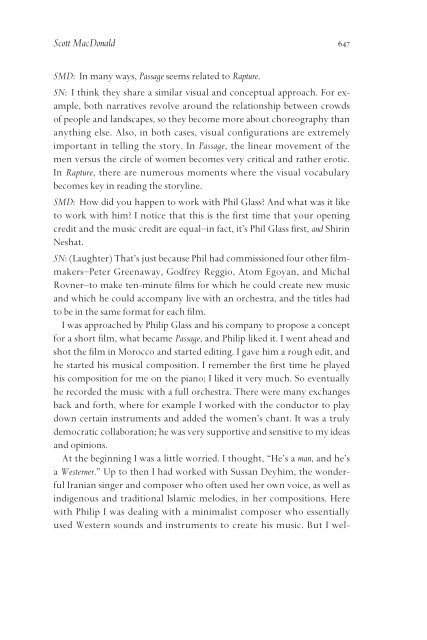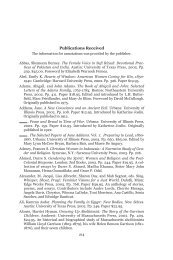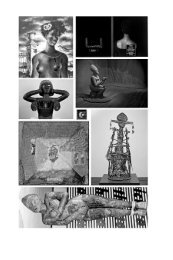An Interview with Shirin Neshat - Feminist Studies
An Interview with Shirin Neshat - Feminist Studies
An Interview with Shirin Neshat - Feminist Studies
Create successful ePaper yourself
Turn your PDF publications into a flip-book with our unique Google optimized e-Paper software.
Scott MacDonald 647<br />
SMD: In many ways, Passage seems related to Rapture.<br />
SN: I think they share a similar visual and conceptual approach. For example,<br />
both narratives revolve around the relationship between crowds<br />
of people and landscapes, so they become more about choreography than<br />
anything else. Also, in both cases, visual configurations are extremely<br />
important in telling the story. In Passage, the linear movement of the<br />
men versus the circle of women becomes very critical and rather erotic.<br />
In Rapture, there are numerous moments where the visual vocabulary<br />
becomes key in reading the storyline.<br />
SMD: How did you happen to work <strong>with</strong> Phil Glass? <strong>An</strong>d what was it like<br />
to work <strong>with</strong> him? I notice that this is the first time that your opening<br />
credit and the music credit are equal–in fact, it’s Phil Glass first, and <strong>Shirin</strong><br />
<strong>Neshat</strong>.<br />
SN: (Laughter) That’s just because Phil had commissioned four other filmmakers–Peter<br />
Greenaway, Godfrey Reggio, Atom Egoyan, and Michal<br />
Rovner–to make ten-minute films for which he could create new music<br />
and which he could accompany live <strong>with</strong> an orchestra, and the titles had<br />
to be in the same format for each film.<br />
I was approached by Philip Glass and his company to propose a concept<br />
for a short film, what became Passage, and Philip liked it. I went ahead and<br />
shot the film in Morocco and started editing. I gave him a rough edit, and<br />
he started his musical composition. I remember the first time he played<br />
his composition for me on the piano; I liked it very much. So eventually<br />
he recorded the music <strong>with</strong> a full orchestra. There were many exchanges<br />
back and forth, where for example I worked <strong>with</strong> the conductor to play<br />
down certain instruments and added the women’s chant. It was a truly<br />
democratic collaboration; he was very supportive and sensitive to my ideas<br />
and opinions.<br />
At the beginning I was a little worried. I thought, “He’s a man, and he’s<br />
a Westerner.” Up to then I had worked <strong>with</strong> Sussan Deyhim, the wonderful<br />
Iranian singer and composer who often used her own voice, as well as<br />
indigenous and traditional Islamic melodies, in her compositions. Here<br />
<strong>with</strong> Philip I was dealing <strong>with</strong> a minimalist composer who essentially<br />
used Western sounds and instruments to create his music. But I wel-




